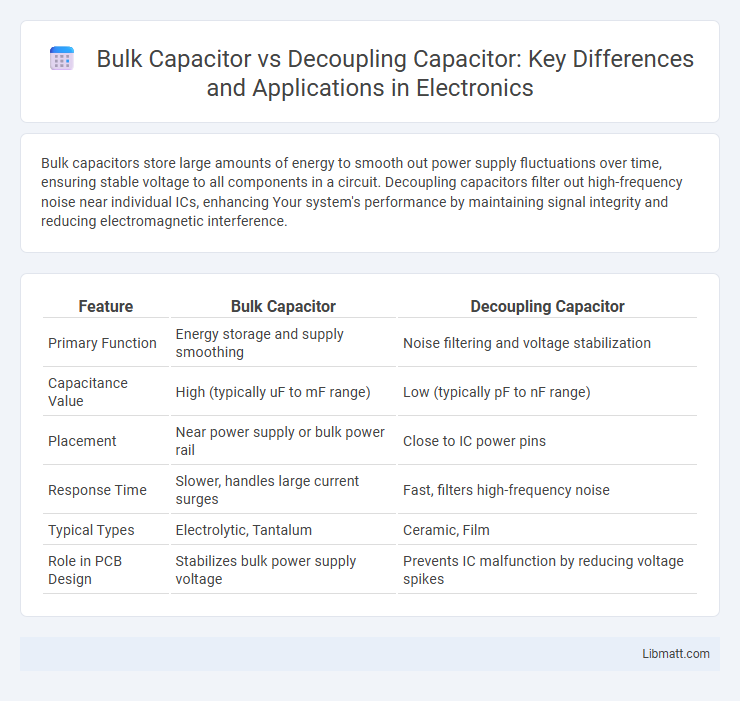Bulk capacitors store large amounts of energy to smooth out power supply fluctuations over time, ensuring stable voltage to all components in a circuit. Decoupling capacitors filter out high-frequency noise near individual ICs, enhancing Your system's performance by maintaining signal integrity and reducing electromagnetic interference.
Table of Comparison
| Feature | Bulk Capacitor | Decoupling Capacitor |
|---|---|---|
| Primary Function | Energy storage and supply smoothing | Noise filtering and voltage stabilization |
| Capacitance Value | High (typically uF to mF range) | Low (typically pF to nF range) |
| Placement | Near power supply or bulk power rail | Close to IC power pins |
| Response Time | Slower, handles large current surges | Fast, filters high-frequency noise |
| Typical Types | Electrolytic, Tantalum | Ceramic, Film |
| Role in PCB Design | Stabilizes bulk power supply voltage | Prevents IC malfunction by reducing voltage spikes |
Introduction to Bulk Cap and Decoupling Cap
Bulk capacitors provide large capacitance values to stabilize power supplies by smoothing voltage fluctuations and supplying energy during transient loads. Decoupling capacitors, typically smaller in value, are placed near integrated circuits to filter high-frequency noise and prevent signal interference. Both components are essential for maintaining stable and reliable electronic circuit operation.
Defining Bulk Capacitors
Bulk capacitors are large-value capacitors designed to store and release significant amounts of electrical energy, stabilizing voltage and filtering low-frequency noise in power supplies. They primarily handle energy reserves and supply current during transient conditions, ensuring steady power delivery in electronic circuits. In contrast, decoupling capacitors are smaller and positioned close to integrated circuits to filter high-frequency noise and provide localized energy storage for rapid switching.
Defining Decoupling Capacitors
Decoupling capacitors are specialized capacitors placed close to integrated circuits to stabilize voltage supply by filtering out noise and transient voltage spikes. Unlike bulk capacitors that provide large energy storage for overall power stability, decoupling capacitors offer rapid response to sudden current demands, ensuring reliable performance of high-speed digital circuits. Understanding the role of decoupling capacitors helps you optimize power integrity and minimize electromagnetic interference in your electronic designs.
Key Differences Between Bulk and Decoupling Caps
Bulk capacitors store and supply large amounts of charge to support the overall power rail and maintain voltage stability during high load demands. Decoupling capacitors, placed near IC pins, filter out high-frequency noise and provide localized energy to prevent voltage spikes and signal integrity issues. Understanding the key differences helps optimize your circuit's performance by balancing bulk energy storage with high-frequency noise suppression.
Roles of Bulk Capacitors in Power Systems
Bulk capacitors play a crucial role in power systems by providing large energy storage to stabilize voltage and smooth out fluctuations caused by load changes or power supply variations. These capacitors ensure consistent power delivery by compensating for transient currents and minimizing voltage drops over longer timeframes. Your system's reliability improves significantly as bulk capacitors maintain overall voltage stability and reduce stress on other components.
Functions of Decoupling Capacitors in Circuit Design
Decoupling capacitors stabilize voltage levels by filtering out noise and transient fluctuations, ensuring that sensitive components receive a clean power supply. Unlike bulk capacitors that provide energy storage for larger loads, decoupling capacitors are placed close to integrated circuits to minimize voltage dips during switching events. Your circuit's performance and reliability improve as these capacitors reduce electromagnetic interference and maintain signal integrity.
Typical Applications for Bulk and Decoupling Capacitors
Bulk capacitors are typically used in power supply filters, energy storage systems, and motor drives where high capacitance and energy buffering are essential. Decoupling capacitors are commonly placed near integrated circuits and microcontrollers to stabilize voltage and reduce noise from rapid transient current demands. Your electronic designs benefit from strategically combining bulk and decoupling capacitors to ensure stable power delivery and signal integrity.
Criteria for Selecting Bulk vs Decoupling Capacitors
Bulk capacitors are selected based on high capacitance and low equivalent series resistance (ESR) to stabilize voltage during large load transients, making them ideal for energy storage on power rails. Decoupling capacitors require low inductance and fast transient response to filter high-frequency noise near integrated circuits, ensuring signal integrity and reducing electromagnetic interference (EMI). Your choice depends on the application's frequency range, ripple current demands, and physical layout constraints to optimize overall power supply performance.
Best Practices for Placement and Sizing
Bulk capacitors should be placed close to the power source or power entry point to stabilize voltage and handle low-frequency ripple, with values typically ranging from 10uF to several hundred microfarads depending on the load current and voltage requirements. Decoupling capacitors need to be positioned near integrated circuits and sensitive components to filter high-frequency noise and improve transient response, often sized between 0.01uF and 1uF for effective high-frequency impedance reduction. Optimal placement minimizes loop area and parasitic inductances, while capacitor sizing balances energy storage needs and frequency response to ensure stable power delivery and noise suppression.
Conclusion: Bulk Cap vs Decoupling Cap in Modern Electronics
Bulk capacitors provide high capacitance values essential for stabilizing voltage supply and handling low-frequency load variations in modern electronics. Decoupling capacitors offer rapid transient response and reduce high-frequency noise near integrated circuits, ensuring signal integrity. Combining bulk and decoupling capacitors optimizes power distribution network performance by addressing both low- and high-frequency requirements effectively.
Bulk Cap vs Decoupling Cap Infographic

 libmatt.com
libmatt.com